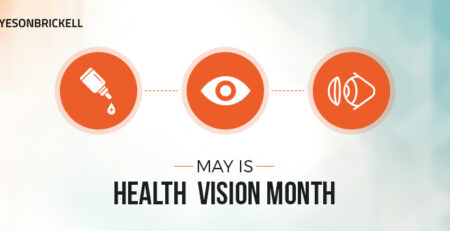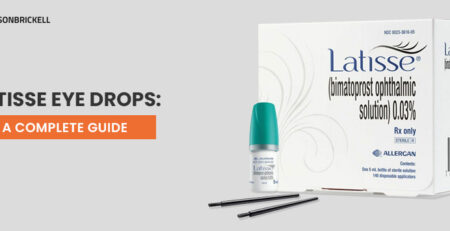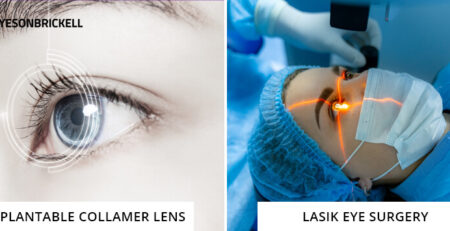Glaucoma Awareness Month: Knowing The Types Of Glaucoma!
Glaucoma is a progressive eye condition that can lead one to permanent blindness, if not identified and managed on time. Did you know that approximately 3 million Americans have glaucoma? The Centers for Disease Control and Prevention (CDC) predicts this number will increase to 4.2 million by 2030.
That is why the Glaucoma Research Foundation has declared January as Glaucoma Awareness Month to spread awareness about this disease, which accounts for 9 to 12% of cases of blindness in the U.S.
According to the Glaucoma Research Foundation, glaucoma is an eye disease that can cause partial vision loss or complete blindness by damaging the optic nerve. This eye problem does not have any early-stage symptoms. That means you will not know about glaucoma until it is too late. That is why Dr. Antoine Copty, the best glaucoma eye doctor in Miami, suggests getting your eyes tested regularly. If you have glaucoma, you can manage it early.
However, glaucoma has different types. Unfortunately, most glaucoma types do not have early symptoms. That is why we have come up with this post explaining different types of glaucoma to help you understand the differences and treatments accordingly.
Also read: What are the Symptoms, Causes, And Treatments of Glaucoma Eye Disease?
Types Of Glaucoma
Glaucoma has two major types, which are:
- Primary Glaucoma
- Secondary Glaucoma
Primary Glaucoma
As you know, other medical conditions, like diabetes, Kartagener syndrome, Sickling disorders, and more, can lead to some types of glaucoma. However, if the doctor cannot find a medical condition that can cause glaucoma, it is identified as primary glaucoma. Primary glaucoma does have different subtypes. These subtypes are:
Open-Angle Glaucoma: It is the most common type of glaucoma in the USA, where 9 in 10 people have suffered from open-angle glaucoma. Usually, the patient does not have any symptoms of open-angle glaucoma until they start to lose their vision. The professionals are still not sure what causes open-angle glaucoma. However, some researchers indicate that open-angle glaucoma may be caused due to pressure building up in your eye.
According to some research, if the fluid in a person’s eye can not drain fast enough, it can create pressure that will push on the optic nerve in the back of the eye. This pressure damages the optic nerve over time, affecting a person’s vision, which can lead to blindness. Dr. Antoine Copty, the best eye doctor for glaucoma, suggests that if someone has open-angle glaucoma, they should go for medicines, laser treatment, or surgery.
Normal-Tension Glaucoma: Normal-tension glaucoma is an open-angle glaucoma in someone with normal eye pressure. You may be at a greater risk of developing this condition if you have the following:
- Japanese lineage
- A family history of normal-tension glaucoma
- Specific heart problems, such as an irregular heartbeat or low blood pressure
The root cause of normal-tension glaucoma is still unknown, but experts recommend treatments that lower eye pressure to slow down the disease and prevent vision loss.
Angle-Closure Glaucoma: Also known as narrow-angle or acute glaucoma, angle-closure glaucoma is a medical emergency. Visit the best glaucoma eye specialist or glaucoma eye exam in Miami if you suddenly have:
- Unbearable eye pain
- Nausea
- Blurry vision
- Red eyes
Angle-closure glaucoma happens when the edge of the iris blocks fluid from draining out of the eye, causing a sudden increase in eye pressure. This can lead to blindness if left untreated. A doctor can use laser treatment and medication to help drain the fluid and protect your vision. If you have angle-closure glaucoma in one eye, your doctor may treat both eyes to prevent future problems. Slow or chronic angle-closure glaucoma happens more slowly and may have no symptoms but can still be treated with medicines, laser treatments, or surgery.
Congenital Glaucoma: Unlike other types, congenital glaucoma affects babies that are born with an issue in their eyes, keeping fluid from draining normally. This condition is rare, as only one in ten thousand American infants have it. You can identify quickly if your baby is born with congenital glaucoma, as the kids with it:
- Have cloudy eyes
- Make extra treas
- Have sensitive eyes to light
- May have larger eyes
According to Dr. Copty, the best treatment for congenital glaucoma is surgery. If a baby gets the surgery early, you can save your kid from permanent vision loss.
Secondary Glaucoma
Unlike primary glaucoma, any eye trauma or medical condition, including severe eye injury, cataract, tumor, or diabetes, can cause secondary glaucoma. The sub-types of secondary glaucoma are:
Neovascular Glaucoma: When a person’s eye makes extra blood vessels that can cover the part of their eyes where fluid drains, typically, the person suffers from neovascular glaucoma. Medical conditions like high blood pressure or diabetes usually cause this condition. A person with neovascular glaucoma may notice
- Vision loss
- Redness in the eyes
- Eye pain
Neovascular glaucoma can be challenging to treat because the doctor will have to treat the underlying cause first. After the underlying cause, like diabetes or high blood pressure, the doctor will treat glaucoma to lower the patient’s eye pressure. According to the best glaucoma doctors, proper medicines, laser treatment, and surgery are the best treatments for neovascular glaucoma.
Pigmentary Glaucoma: It is known as pigmentary glaucoma when the iris pigment flakes off and blocks the eye fluid from draining. Young white men with nearsightedness, also known as myopia, are more likely affected by pigmentary glaucoma. The person with pigmentary glaucoma may have blurry vision or see rainbow-colored rings around lights, especially when the person is doing physical activity like exercise. Although, professionals can treat pigmentary glaucoma by lowering eye pressure. Still, they cannot find a way to prevent pigment from flaking off the iris.
Exfoliation Glaucoma: Exfoliation glaucoma, also known as pseudoexfoliation glaucoma, is an open-angle glaucoma that occurs in some people with exfoliation syndrome. Exfoliation syndrome is characterized by accumulating a flaky, white material on certain eye parts, such as the iris, lens, and ciliary body. This material, made up of abnormal protein fibers, can block fluid drainage from the eye, increasing intraocular pressure.
Recent research suggests that genetics may play a role in developing exfoliation glaucoma. People with a family history of exfoliation glaucoma are at a higher risk of developing the condition themselves. Specific genes that may increase susceptibility to exfoliation syndrome and its associated glaucoma have also been identified.
Exfoliation glaucoma can progress more rapidly than primary open-angle glaucoma, the most common type. It also tends to cause higher intraocular pressure, which can cause damage to the optic nerve and lead to vision loss. For this reason, it is crucial for people at risk for exfoliation glaucoma to have regular eye exams to monitor their intraocular pressure and detect any signs of glaucoma early. Treatment options for exfoliation glaucoma may include eye drops, laser surgery, or conventional surgery to lower intraocular pressure and preserve vision.
Uveitic Glaucoma: Uveitic glaucoma is a type of glaucoma that can occur in people with uveitis, which is an inflammatory disease that affects the eye. Uveitis can cause swelling and inflammation in different eye parts, including the middle layer of tissue (uvea) that supplies blood to the retina. The uvea also contains the ciliary body, which produces the fluid (aqueous humor) that nourishes the eye and maintains its shape.
When uveitis affects the ciliary body, it can cause inflammation and scarring that block the drainage channels (trabecular meshwork) that allow the aqueous humor to flow out of the eye. This leads to increased intraocular pressure (IOP), which can damage the optic nerve and cause vision loss over time. Uveitic glaucoma can occur in about 2 out of 10 people with uveitis. Still, the risk can vary depending on the severity and duration of the uveitis and other factors such as age, race, and genetics.
Experts are still not entirely sure how uveitis causes uveitic glaucoma, but they believe the inflammation and scarring in the ciliary body and trabecular meshwork play a crucial role. In some cases, uveitic glaucoma can also result from the use of corticosteroid medications that are commonly prescribed to treat uveitis. These medications can increase IOP by reducing the outflow of aqueous humor or increasing its production, primarily if used for an extended period or at high doses. It’s essential to monitor IOP regularly in people with uveitis who are using corticosteroids and adjust the treatment as needed to prevent or manage uveitic glaucoma.
Quick Tips to Manage Glaucoma
Understand the Risks: Knowing the risks is the best way to stay safe from this eye condition. You can discuss potential risk factors with a professional like Dr. Copty, one of the best eye specialists in Miami, for further assistance. Moreover, if you have any family health history, ask questions and stay informed.
Protect Your Eyes: Eye injuries can increase the risk of developing eye conditions, including glaucoma. So, wear eye protection while playing sports or working in hazardous conditions.
Manage Your Overall Health: As mentioned before, if you have any health issues, like diabetes, high blood pressure, or more, you are more likely to be affected by glaucoma. So maintain a healthy weight, stay active, eat well, manage diabetes, and control blood pressure to save your vision.
Get a Frequent Eye Exam: The best way to save yourself from glaucoma is to get a glaucoma eye exam every one to two years. You can contact us at Eyes on Brickell for the best eye exam and eye care service in Miami, Brickell.
Contact Eyes on Brickell For The Best Eyecare Services in Miami
At Eyes on Brickell, we always go above and beyond to ensure our patients receive high-quality eye care and services. Since we understand how severe glaucoma can be, we compelled this post to spread awareness about glaucoma and its types this January. If you are also dealing with glaucoma, Keratoconus, or other eye conditions, we are here to help. All you need to do is make an appointment with us at Eyes on Brickell and let us provide you with the best eye care services in Miami.












